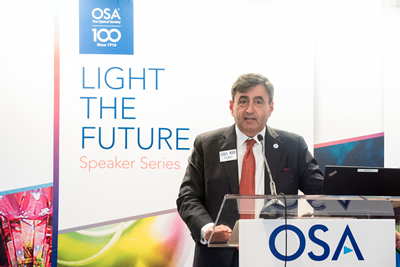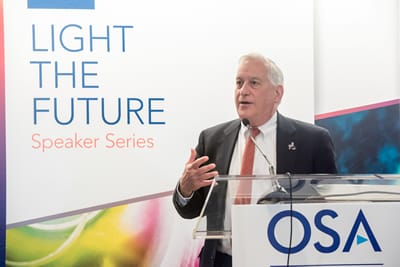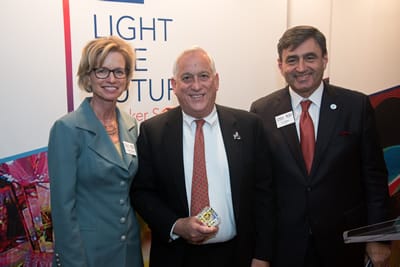Great Innovators - How they collaborate and why their teamwork leads to more creativity
Rebecca B. Andersen
The Optical Society (OSA) continued the tradition of the Light the Future speaker series on 8 February 2017. The speaker series, which began in OSA’s centennial year, was created to shine light on the special contributions and innovations in optics and photonics. Walter Isaacson, president and CEO of the Aspen Institute, a nonpartisan educational and policy studies institute, detailed great collaborative efforts and innovations in science.
As the author of “The Innovators” (2014), “Steve Jobs” (2011), “Einstein: His Life and Universe” (2007), “Benjamin Franklin: An American Life” (2003), “Kissinger: A Biography” (1992), and coauthor of “The Wise Men: Six Friends and the World They Made” (1986), Walter Isaacson knows the life stories of our greatest innovators. In 1996 Isaacson served TIME as the 14th editor, before moving to CNN to become the chairman and CEO in 2001. In 2003, Isaacson moved to Washington, DC to join the Aspen Institute as president and CEO, where his focus is on the development of value-based leadership.
“Poetical Science” with Ada Lovelace
In his presentation, Walter Issaccson went back in history to look at those that did the best at combining the arts and the sciences. Analyst, metaphysician and founder of scientific computing, Ada Lovelace went on to start a digital revolution in a time when noblewomen in intellectual pursuits were not widely encouraged. It was science that gave her life its wings and she went onto use the term “poetical science” to describe her passion for both poetry and the algorithms of math and sceince. That was her mental leap into this notion that we can get the human creativity, this notion of beauty and art and patterns, and do it in a way that can instruct machines. That would be the symbiosis. Not machines replacing humans, but somehow a real partnership of humans and machines. That's what she starts with this notion, at least in the digital age, of the connection of art and science.
Can Machines Think?
Exactly 100 years after Ada published her research on the first computer program, Alan Turing, widely considered to be the father of theoretical computer science and artificial intelligence, went on to postulate that machines will be able to do anything a human can do in the future. He developed the famous Turing test that if you put a machine and a human behind different doors and send them in questions and you can't tell which is which, there's no logical reason to say the machine is not thinking. It really sets up this tension that we're feeling now in the modern age between those who believe that we'll reach a singularity and our machines will replace us, versus those who believe that the symbiosis, the connection of humans and machines, will always increase at a more powerful rate than machines alone or humans alone, and that it is the interface, the connection, between humans and machines that's our great challenge.
At the Cornerstone of the Digital Revolution
After World War II, Bell Labs changes direction to focus on materials research, computing and wireless technologies. They end up doing something that totally transforms lives, which is figuring out how to turn silicone into a vacuum tube and then how to etch onto a chip of silicone not only thousands and millions of transistors, but the entire micro-processor or whatever you need, to create personal computers. Today’s data explosion has brought new challenges to networks — achieving sufficient network capacity, coverage and reach, and simultaneously lowering the economic and environmental impact. Bell Labs has pushed the boundaries of intelligent networking with new breakthroughs in copper, wireless and optical communications.
The Symbiosis Between Human Values and Today’s Emerging Technologies
Cross-company collaboration was the key ingredient to the innovations developed at Bell Labs and the question is — what’s next? Isaacson believes we're involved in a whole new frontier of innovation. It's not something that can be done in a dorm room. It's not like Facebook and it's not like Google. It's not something that can be done in a garage. It tends to involve really big data, the analysis of big data, and applying it both to the life sciences and other things. It also requires a connection of creativity. A connection of our humanity to these things. It is the people still who are able to bring that creative instinct into the world of technology that are forming the great new ideas that are pushing us into the future.
Today, we're looking at a combination of the life sciences, physical sciences and data sciences in a new light. Isaccson believes this combination will be the driver of our next human revolution. Large teams from around the world have been involved in substanial discoveries – from gravitational waves to the gene sequencing, Crisper – underpinning the way forward in the digital age of the future. Combining big data in a way that the information can be manipulated and extracted to support humanity, is what Ada Lovelace, Edwin Land, Steve Jobs, all believed in – a symbiosis between human values and today’s emerging technologies.

Eric Mazur, 2017 President of The Optical Society introduces Walter Isaacson

Walter Isaacson, CEO of The Aspen Institute

Elizabeth Rogan, CEO of The Optical Society; Walter Isaacson, CEO of The Aspen Institute; Eric Mazur, 2017 President of The Optical Society
